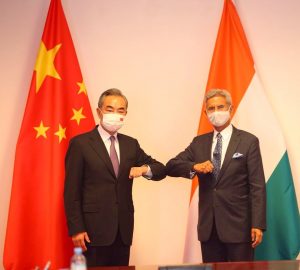Rajeswari Pillai Rajagopalan

The MEA said in its press release after the meeting that the two ministers exchanged views on the current situation on the LAC in Eastern Ladakh and also broader issues in India-China relations. There was clearly very little that the two ministers agreed on, and the press release was not shy about indicating this. The only point of agreement, outlined in the last paragraph of the Indian statement, was an agreement that the Working Mechanism for Consultation and Coordination (WMCC), the convoluted title of the negotiating mechanism that has been dealing with the recent border disagreements, will meet again and that, in the meantime, neither side would take any unilateral measures.
Interestingly, the MEA statement devoted two full paragraphs to Jaishankar apparently lecturing the Chinese foreign minister on the Chinese responsibility for the current problems facing bilateral relations, which appears to be a none-too-subtle signal to China. Jaishankar “emphasized the need to follow through” on the commitments reached at their previous meeting in September 2020. He “pointed out” to Wang that the successful disengagement in the Pangong Lake area has facilitated better conditions for resolving the remaining issues on the LAC, adding, “It was expected that the Chinese side would work with us towards this objective.” Jaishankar “noted” that nevertheless, the situation was still unresolved. He “emphasized” that the “maintenance of peace and tranquility in the border areas has been the foundation for the development of ties since 1988.” He apparently (again) emphasized that “it was, therefore, in mutual interest that the two sides work towards early resolution of the remaining issues along the LAC in Eastern Ladakh.” The MEA press release also noted that the two ministers also had an understanding that “both sides will continue to ensure stability on the ground and neither side will take any unilateral action that could increase tension.”
If the MEA statement is to be believed, the Chinese foreign minister had little to say in response. It was simply a lecture by the Indian foreign minister. If the press statement is a signal to China, the message is clear: India is angry. Whether China gets the message or cares about it is another matter altogether.
The meeting comes against the backdrop of contradictory reports of a new clash in Eastern Ladakh. A report in the Indian newspaper Business Standard, quoting sources operating in Eastern Ladakh, claimed that “there has been at least one clash between the two sides.” According to the report, which was by a well-known Indian defense correspondent, Ajai Shukla, the clash took place on the Galwan River but there is no information on any casualties. According to other reports, the Indian Army denied that there was any fresh clash between Indian and Chinese troops in Eastern Ladakh. The army went on to add that “no attempt has been made by either side to occupy the areas from where the forces had disengaged after the agreement in February this year.” At the same time, the report also a quoted a defense source as saying that “there has been a gradual build-up of Chinese troops and equipment on their side of the LAC. India has also proportionately put in thousands of troops and deployed additional assets in the region.” The same report said that according to another defense source, minor incidents between Indian and Chinese forces do happen because of the proximity of the forces to each other but that “such incidents are far and few and extremely localized. They are immediately brought under control by the subordinate commanders at the local level and do not impact the overall situation.” Though it is not entirely certain, this could also be referring to the clash that Shukla reported.
These reports, along with the MEA press release of the two foreign ministers’ meeting, suggest that all is not well. After the meeting, Jaishankar in a tweet said that he “highlighted that unilateral change of status quo is not acceptable. Full restoration and maintenance of peace and tranquility in border areas is essential for development of our ties.”
The Chinese Ministry of Foreign Affairs had a different take on the entire issue. According to the ministry, Wang remarked that “The two sides must place the border issue in an appropriate position in bilateral relations, expand the positive momentum of bilateral cooperation and create favorable conditions for resolving differences through negotiation.”
In short, both sides are sticking to their positions: India, that the problem is of China’s making and unless it is resolved, Sino-Indian relations cannot move forward; and China, that the problem should be put aside while focusing on other aspects of the relations.
No comments:
Post a Comment